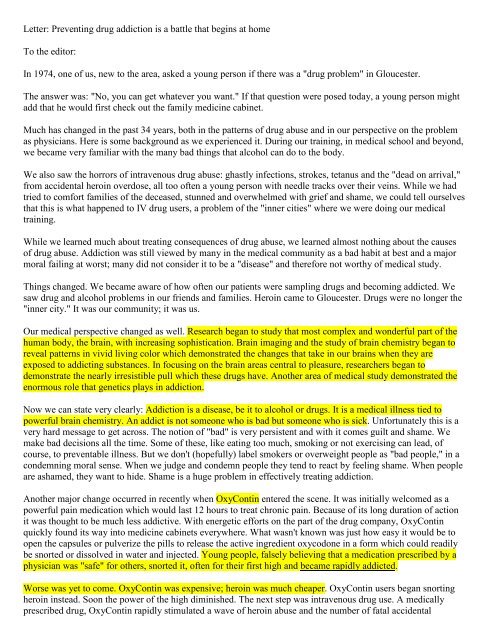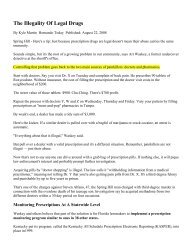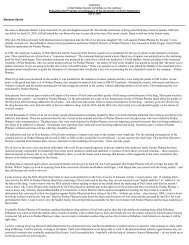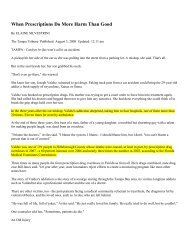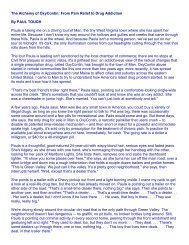Letter: Preventing drug addiction is a battle that begins at home To ...
Letter: Preventing drug addiction is a battle that begins at home To ...
Letter: Preventing drug addiction is a battle that begins at home To ...
- No tags were found...
You also want an ePaper? Increase the reach of your titles
YUMPU automatically turns print PDFs into web optimized ePapers that Google loves.
<strong>Letter</strong>: <strong>Preventing</strong> <strong>drug</strong> <strong>addiction</strong> <strong>is</strong> a <strong>b<strong>at</strong>tle</strong> <strong>th<strong>at</strong></strong> <strong>begins</strong> <strong>at</strong> <strong>home</strong><strong>To</strong> the editor:In 1974, one of us, new to the area, asked a young person if there was a "<strong>drug</strong> problem" in Gloucester.The answer was: "No, you can get wh<strong>at</strong>ever you want." If <strong>th<strong>at</strong></strong> question were posed today, a young person mightadd <strong>th<strong>at</strong></strong> he would first check out the family medicine cabinet.Much has changed in the past 34 years, both in the p<strong>at</strong>terns of <strong>drug</strong> abuse and in our perspective on the problemas physicians. Here <strong>is</strong> some background as we experienced it. During our training, in medical school and beyond,we became very familiar with the many bad things <strong>th<strong>at</strong></strong> alcohol can do to the body.We also saw the horrors of intravenous <strong>drug</strong> abuse: ghastly infections, strokes, tetanus and the "dead on arrival,"from accidental heroin overdose, all too often a young person with needle tracks over their veins. While we hadtried to comfort families of the deceased, stunned and overwhelmed with grief and shame, we could tell ourselves<strong>th<strong>at</strong></strong> th<strong>is</strong> <strong>is</strong> wh<strong>at</strong> happened to IV <strong>drug</strong> users, a problem of the "inner cities" where we were doing our medicaltraining.While we learned much about tre<strong>at</strong>ing consequences of <strong>drug</strong> abuse, we learned almost nothing about the causesof <strong>drug</strong> abuse. Addiction was still viewed by many in the medical community as a bad habit <strong>at</strong> best and a majormoral failing <strong>at</strong> worst; many did not consider it to be a "d<strong>is</strong>ease" and therefore not worthy of medical study.Things changed. We became aware of how often our p<strong>at</strong>ients were sampling <strong>drug</strong>s and becoming addicted. Wesaw <strong>drug</strong> and alcohol problems in our friends and families. Heroin came to Gloucester. Drugs were no longer the"inner city." It was our community; it was us.Our medical perspective changed as well. Research began to study <strong>th<strong>at</strong></strong> most complex and wonderful part of thehuman body, the brain, with increasing soph<strong>is</strong>tic<strong>at</strong>ion. Brain imaging and the study of brain chem<strong>is</strong>try began toreveal p<strong>at</strong>terns in vivid living color which demonstr<strong>at</strong>ed the changes <strong>th<strong>at</strong></strong> take in our brains when they areexposed to addicting substances. In focusing on the brain areas central to pleasure, researchers began todemonstr<strong>at</strong>e the nearly irres<strong>is</strong>tible pull which these <strong>drug</strong>s have. Another area of medical study demonstr<strong>at</strong>ed theenormous role <strong>th<strong>at</strong></strong> genetics plays in <strong>addiction</strong>.Now we can st<strong>at</strong>e very clearly: Addiction <strong>is</strong> a d<strong>is</strong>ease, be it to alcohol or <strong>drug</strong>s. It <strong>is</strong> a medical illness tied topowerful brain chem<strong>is</strong>try. An addict <strong>is</strong> not someone who <strong>is</strong> bad but someone who <strong>is</strong> sick. Unfortun<strong>at</strong>ely th<strong>is</strong> <strong>is</strong> avery hard message to get across. The notion of "bad" <strong>is</strong> very pers<strong>is</strong>tent and with it comes guilt and shame. Wemake bad dec<strong>is</strong>ions all the time. Some of these, like e<strong>at</strong>ing too much, smoking or not exerc<strong>is</strong>ing can lead, ofcourse, to preventable illness. But we don't (hopefully) label smokers or overweight people as "bad people," in acondemning moral sense. When we judge and condemn people they tend to react by feeling shame. When peopleare ashamed, they want to hide. Shame <strong>is</strong> a huge problem in effectively tre<strong>at</strong>ing <strong>addiction</strong>.Another major change occurred in recently when OxyContin entered the scene. It was initially welcomed as apowerful pain medic<strong>at</strong>ion which would last 12 hours to tre<strong>at</strong> chronic pain. Because of its long dur<strong>at</strong>ion of actionit was thought to be much less addictive. With energetic efforts on the part of the <strong>drug</strong> company, OxyContinquickly found its way into medicine cabinets everywhere. Wh<strong>at</strong> wasn't known was just how easy it would be toopen the capsules or pulverize the pills to release the active ingredient oxycodone in a form which could readilybe snorted or d<strong>is</strong>solved in w<strong>at</strong>er and injected. Young people, falsely believing <strong>th<strong>at</strong></strong> a medic<strong>at</strong>ion prescribed by aphysician was "safe" for others, snorted it, often for their first high and became rapidly addicted.Worse was yet to come. OxyContin was expensive; heroin was much cheaper. OxyContin users began snortingheroin instead. Soon the power of the high dimin<strong>is</strong>hed. The next step was intravenous <strong>drug</strong> use. A medicallyprescribed <strong>drug</strong>, OxyContin rapidly stimul<strong>at</strong>ed a wave of heroin abuse and the number of f<strong>at</strong>al accidental
overdoses skyrocketed. By 2005 there were five times as many overdoses compared to 1990. In Gloucester therewere 19 f<strong>at</strong>al overdoses between 2004 and 2006, a r<strong>at</strong>e over two and a half times <strong>th<strong>at</strong></strong> of Massachusetts.While we physicians have always known <strong>th<strong>at</strong></strong> some of our p<strong>at</strong>ients would abuse some of the medic<strong>at</strong>ions weprescribed; we just had no idea of the extent to which we were becoming part of the problem.Gloucester <strong>is</strong> very fortun<strong>at</strong>e to have a Public Health Department which has stepped up to the pl<strong>at</strong>e to comb<strong>at</strong> theopi<strong>at</strong>e (heroin/OxyContin) problem in our city. The department has developed numerous programs over the pastdecade to provide educ<strong>at</strong>ion, prevention str<strong>at</strong>egies and all manner of services for people dealing with the terribleproblems IV <strong>drug</strong> abuse can produce — HIV/AIDS and hep<strong>at</strong>it<strong>is</strong> C, to name just two. Programs, of course, costmoney, and the DPH has been cre<strong>at</strong>ive in securing various grants to sustain its activities.We are writing to urge citizens to particip<strong>at</strong>e in the most recent <strong>at</strong>tempt to prevent <strong>drug</strong> abuse and <strong>addiction</strong>.The new Gloucester Medic<strong>at</strong>ions D<strong>is</strong>posal Program, a collabor<strong>at</strong>ion of physicians, pharmac<strong>is</strong>ts, the GloucesterPolice Department and Gloucester Health Department, provides opportunities for us all to d<strong>is</strong>pose thesemedic<strong>at</strong>ions <strong>at</strong> the Gloucester Police Department on a continuous bas<strong>is</strong> <strong>at</strong> anytime, as well as <strong>at</strong> senior housing,Rose Baker Senior Center, flu clinics and <strong>at</strong> quarterly events to begin th<strong>is</strong> month.Please check the Times for d<strong>at</strong>es and loc<strong>at</strong>ions. <strong>To</strong> ease any concerns with anonymity, medic<strong>at</strong>ions can bedelivered in plastic baggies and, if in vials, you can remove or "black out" any and all inform<strong>at</strong>ion.Remember, reducing and preventing <strong>addiction</strong> <strong>is</strong> a very complex problem, one without a single solution. But weknow there are partial solutions and we believe <strong>th<strong>at</strong></strong> the Gloucester Medic<strong>at</strong>ions D<strong>is</strong>posal Program <strong>is</strong> an excellentone. It <strong>is</strong> aimed <strong>at</strong> stopping the flow of prescribed <strong>drug</strong>s from your medicine cabinet into the wrong, often young,hands, OxyContin most notoriously, but other prescribed medicines which you many have <strong>at</strong> <strong>home</strong> can also be achemical springboard which c<strong>at</strong>apults one of your loved ones into <strong>addiction</strong>. We want you to:1. Remove outd<strong>at</strong>ed and unused medic<strong>at</strong>ions from you <strong>home</strong>: Removing these medic<strong>at</strong>ions keeps youth safe bylimiting access and please do not flush the medic<strong>at</strong>ions, research shows th<strong>is</strong> <strong>is</strong> becoming a hazard to w<strong>at</strong>ersupplies throughout communities. Please particip<strong>at</strong>e in the Gloucester Medic<strong>at</strong>ions D<strong>is</strong>posal Program.2. Secure your medic<strong>at</strong>ions <strong>at</strong> <strong>home</strong>: Recognize <strong>th<strong>at</strong></strong> b<strong>at</strong>hroom medicine cabinets are a regular target of youngpeople who take wh<strong>at</strong> they want and then trade the <strong>drug</strong>s <strong>at</strong> "pharming" parties. Th<strong>is</strong> may sound far-fetched but itreally does happen. Open houses and parties with teens pose a special r<strong>is</strong>k for th<strong>is</strong>.Do your part to stop prescription <strong>drug</strong> abuse in our city. Drug <strong>addiction</strong> <strong>is</strong> not only an illness; it <strong>is</strong> a preventableillness.Dr. Fred Oderhttp://www.gloucestertimes.com/puopinion/local_story_366193452.html


